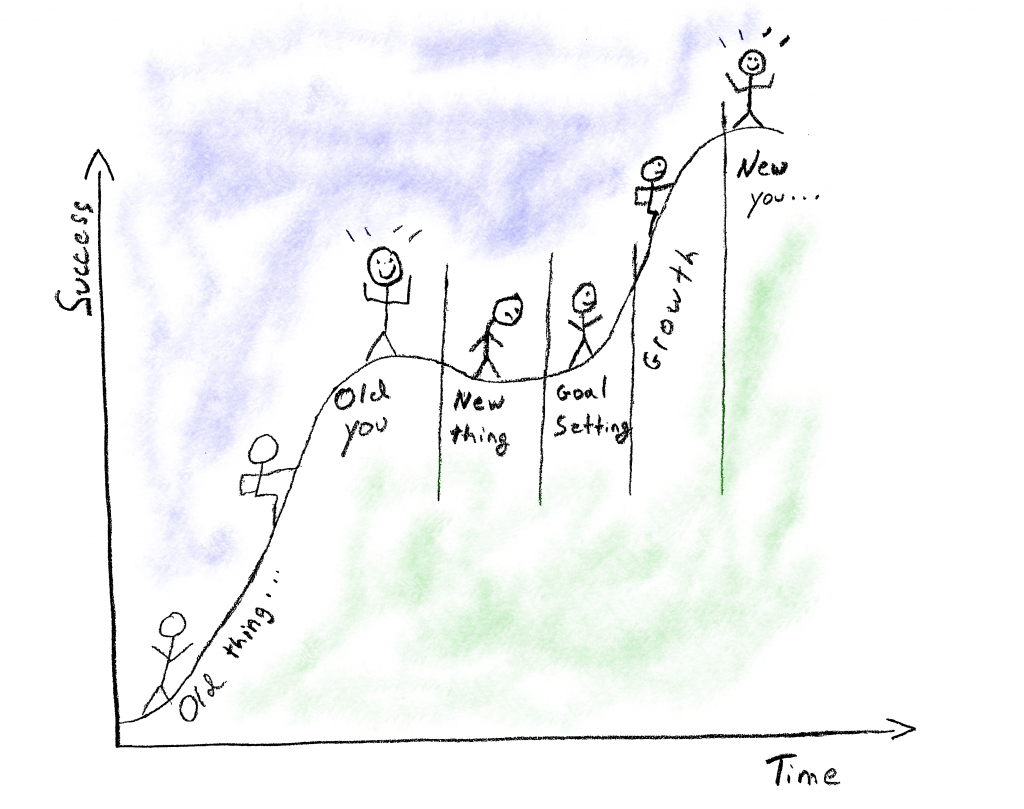A new job, new role, new team, new boss or a new framework..they can cause a lot of anxiety.
Impostor syndrome can sneak up on the most confident of people. If you are less than confident, you might feel..

Meta thought: If S Curve is a new term for you, you are beginning at the bottom of the S Curve’s S Curve!
The S Curves of your career
First, let me try to explain what an S Curve is. An S Curve is your transition along a new role or skill from confusion, to confidence, to mastery. Each point within that curve needs a different approach. The curves come in all sizes and you may be on many curves at once over the different aspects of your life.

Meta thought: As you read this, you might go from beginning to understand an S Curve to how to use them. Soon, you will begin to see yourself on one or two. After a while, you will know how to move yourself along them without feeling stuck. At that point you will have mastered your understanding of S Curves.
Why the beginning is hard
When you start a new skill, many thoughts can go through your head. You may experience anxiety, excitement, confusion, loneliness or adventure. Congratulations, you are on an emotional roller coaster!
Recognizing you are at the bottom of a curve is the first step. When you acknowledge yourself at the bottom, you can start to plan on how to get to the top. Work with your manager on what you will need to develop this skill by creating goals around them. Working with your manager accomplishes two important pieces. One, both you and your manager identify that you are growing by working on a new thing. Two, that you both align on the time to achieve results through SMART goals.
Career advice: Any time you feel yourself struggling, do not get down on yourself. Instead, say “I’m at the bottom of a curve. I’ve been at the bottom of one before and I can get to the top of this one now.”
Stuck in the middle
The middle of the curve is where strange things begin to happen. At times, you struggle and at other times, you feel like a rock star. The middle is a long and lonely place. Depending on the skill, you may find yourself ascending an S Curve for one to two years or even more.
Do not get discouraged and do not get stuck! The middle is where you confront impostor syndrome head on. As part of your weekly routine, review your goals and add mile markers to gauge progress and success. Take notes or journal the important strategies and techniques you are learning and validate them with a coworker.
Career advice: Take notes when you do not feel comfortable. This will allow you to get feedback from a peer, mentor or your manager.
The summit
In sports, an elite athlete might say that the game slows down. They reach a point where their physical and mental approach becomes routine and predictable. That does not mean that they always win or that the road is smooth. At the top of the S Curve of a new skill, you are still confronted with challenges. But, you need less physical, emotional and mental energy required to overcome them.
Short story: As a mid-level engineer, I was nervous when another engineer asked for input on code or a design pattern. As I kept developing my skills over the years, the self doubt went away. Even when wrong, I was confident that I could have a good discussion and could explain the decisions I made. As I began to feel comfortable as a developer, my day to day became predictable and I hit a groove.
I remember a time when working with another senior engineer who was using the package I wrote in their application. I knew the problem they were having was a version incompatibility issue despite their insistence otherwise. Over an hour conversation, I was able to convince them to go in that direction and helped them debug and solve their problem. I was at the top of my S Curve. I spoke with my manager that week about a promotion to senior engineer.
Career advice: Do not dwell on the summit for too long. A rest at the top feels great after a long hike. Over time, you will begin to feel disengaged and bored. Find the next hill to climb!
What S Curve are you on right now? Where are you on the curve?
If you are a manager, a great resource on this topic and many others is 25 Best Practices in Learning and Talent Development by Nick Van Dam.



This is just what I needed to read tonight… keep em coming.
Thanks! I appreciate it.